#apply lei number
Explore tagged Tumblr posts
Text
What is LEI?To increase the precision and quality of financial data systems, parties to financial transactions globally can be uniquely identified by their 20-digit Legal Entity Identifier (LEI).For participants in the over-the-counter (OTC) derivative, non-derivative markets, major corporate..
#Lei certificate#Legal Entity Identifier (LEI)#get LEI number#apply lei number#cross border payment#global transaction#lei code number#lei number
0 notes
Text

GOLDEN MIND, GOLDEN LIFE
✷ when it comes to manifesting self concept is the number one thing, would you go to the cinema without popcorn…? exactly self concept is what makes loa, loa.
✷ i could make countless posts, help people through anon, reblog, share success stories ect. but it all comes down to your sc.
✷ your manifestations feed off your mindset and what you tell yourself. if you’re telling yourself i’m so untalented, ugly ect. that is what’s going to solidify, whatever you say comes true even neville says it!
“the world is a mirror, forever reflecting what you are doing, within yourself.”
- you’re literally just self sabotaging if you look at yourself all day and bring yourself down
“an assumption, though false, if persisted in, will harden into fact.”
- question : do you think artists like beyoncé talk about how she can’t sing, dance, she’s untalented, she’s scared about how she might mess something up?
- no why would she be hyperfixating over something like that. take that advice and apply it to your own life, if you look in the mirror and find a pimple on your forehead talk about how clear your forehead is and how your pimple is gone and not how big and noticeable it is.
⤹
also no matter how far you are in your loa journey it’s okay to go back to the basics!!
- ASSUME - LIVE IN THE END - THE 3D CONFORMS
happy manifesting - lei
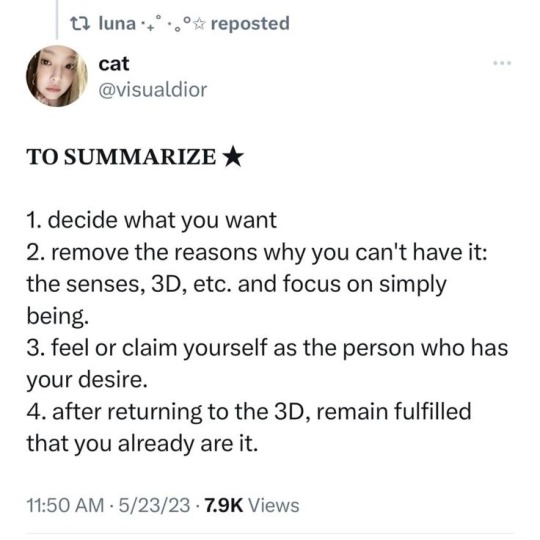

#ㅤㅤㅤㅤㅤ⪩ ⪨ manifestingbymoi ㅤㅤㅤㅤㅤ⪩ ⪨#law of assumption#neville goddard#manifestation#loa#affirmations#dream girl#dream life#self concept#void state#it girl energy#it girl#living in the end#manfiest
384 notes
·
View notes
Photo
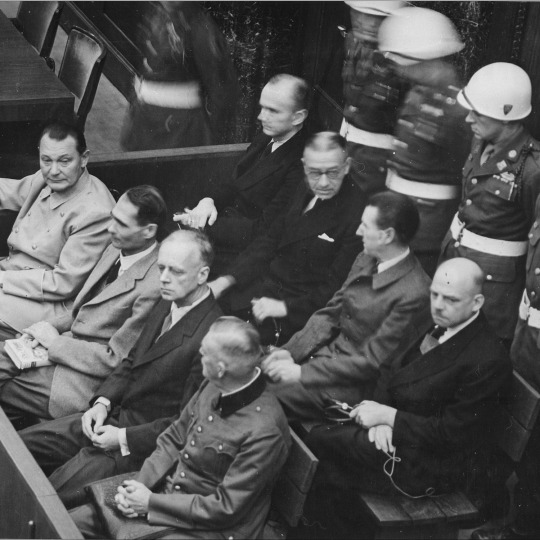
Nuremberg Trials
The Nuremberg trials (1945-6), held in Nürnberg (Nuremberg), Germany, were a series of trials involving the senior surviving Nazis to hold them accountable for waging war and committing war crimes and crimes against humanity during the Second World War (1939-45). 22 Nazis were tried, with 19 found guilty and sentenced to either death by hanging or lengthy prison terms.
The first Nuremberg trials were conducted from November 1945 to October 1946, and then, a second phase, which involved a much larger number of defendants, was conducted from November 1946 to April 1949. The Nuremberg trials were the first in history where the victors in a war sought to make senior figures from the losing side accountable for their actions. The trials were filmed and contributed greatly to our understanding of how WWII was conducted and revealed both the irrefutable evidence for and enormous scale of such atrocities as the Holocaust. The first month of the trials, the initial proceedings only, were hosted in the Supreme Court Building in Berlin, but they moved on 20 November to the Palace of Justice in Nuremberg. The Palace of Justice was selected because it had been the heart of Nazi show trials against enemies of the Third Reich, the city was the home of the Nuremberg Rally, the infamous annual Nazi Party congress, and the complex had the practical advantage of an adjoining prison where the defendants were detained.
The International Military Tribunal
At the close of WWII, the victorious Allies of France, Britain, the United States, and the USSR, as agreed by their respective leaders at a conference in Moscow back in October 1943, jointly formed an International Military Tribunal (IMT) to bring German Nazi war criminals to justice. There were some calls to have judges from neutral nations head the IMT, but the allied leaders were determined to be directly involved in getting their pound of flesh. The idea of the trials was supported by a number of other nations besides the four main powers.
The panel that would decide the fate of the defendants brought before the IMT consisted of one judge and one prosecutor from each of the four nations mentioned above. The judging panel was presided over by the British judge Lord Justice Geoffrey Lawrence, described by one American lawyer as "like God...Hollywood would have cast him" (MacDonald, 23). The chief Soviet judge was I. T. Nikitchenko, the French lead judge was Henri Donnedieu de Vabres, and the US judge was Francis B. Biddle. The legal proceedings followed the common law practice applied in the United States and Britain. Translators worked in the courtroom, and everyone present had access to a set of headphones. There was a large screen to show the court relevant film clips and statistical information. 250 journalists attended the court sessions, and the whole proceedings were filmed and sound recorded.
Nuremberg Trials Judges
U.S. Army (CC BY-NC-SA)
In the closing stages of the war, Adolf Hitler (1889-1945), Joseph Goebbels (1897-1945), and Heinrich Himmler (1900-1945) had all committed suicide, but there remained 24 senior Nazi figures whom the Allies were determined to bring to justice. The group was selected not only for their individual roles but also as representatives of particular Nazi institutions. Before the trials could begin, Robert Ley (1890-1945), head of the German Labour Front, committed suicide, and Gustav Krupp (1870-1950), an industrialist who had used forced labour, was considered too physically frail to stand trial. The 22 remaining defendants faced four charges, as expressed in the Oxford Companion to World War II, they were:
Count 1: Contributing to a common plan or conspiracy to wage war
Count 2: Crimes against peace
Count 3: War crimes (e.g. violations of the Geneva Convention such as the abuse and murder of prisoners of war, use of prisoners for labour, destruction of private property, and devastation of property and places with no military justification)
Count 4: Crimes against humanity (e.g. the murder of civilian populations, use of slave labour, the forced deportation of civilians, and the persecution of specific social, political, religious, and racial groups)
Counts 1 and 2 proved problematic to define, and therefore it was difficult to find the defendants either innocent or guilty of them. This is hardly surprising considering the debate amongst historians ever since as to why and how WWII started and how far one should go back exactly in order to discover the causes of WWII, causes which could be attributed in some cases to both the victors and losers. The court essentially considered counts 1 and 2 as involving actions such as breaking international treaties and invading and occupying free countries. Much easier to establish were cases of counts 3 and 4, although even here there was the added complication that the victors had themselves been guilty of what would today be called war crimes, for example, the Allied bombing of Germany, submarine attacks on unarmed vessels, and the Katyn Forest massacre of Polish prisoners of war by USSR forces. Certain facts were taken as given, such as that Hitler had fully intended to start a world war. In addition, such Nazi organisations as the Gestapo (secret police), the SS (Schutzstaffel), and SA (Sturmabteilung) were condemned as criminal organisations.
Palace of Justice, Nuremberg
US Army (Public Domain)
The judges not only benefitted from the cross-examination of the defendants but also the testimony of around 360 witnesses (including both victims of and members of the Nazi regime) and a huge quantity of incriminating documents, official and otherwise, including indisputable photographs, sound recordings, and films, such as those taken at concentration and death camps. As noted by Dr Robert Kempner, a lawyer who had fled the Nazi regime:
One of the biggest helps to us was the German bureaucratic sense – they kept everything and they even made publications and films and lot of material had been discovered by our Allied search teams. Some of the people like General Governor Frank of Poland was so anxious to show his friend Hitler after the war what he has done that he kept diaries, volumes and volumes and volumes. In fact he had written his own indictment.
(Holmes, 593)
It is important to note, however, that the documentation for Nuremberg was compiled in order to support the legal case that the defendants were guilty of one or more of the four counts (and not to create a comprehensive reconstruction of past events as, say, a historian would do). There was, too, a degree of negotiation between the various national judges regarding particular defendants – the USSR judge, for example, wanted Rudolf Hess hanged while his fellow judges preferred a prison sentence – but there was a conscious effort on all parties to deliberate with as much fairness as possible given the seriousness of the trials and the world's scrutiny of them. To this end, the defendants were collectively represented by a legal counsel, Otto Kranzenbühler, and permitted individual lawyers to present their defence.
Camp Guard Giving Evidence at Nuremberg
Imperial War Museums (CC BY-NC-SA)
Continue reading...
38 notes
·
View notes
Text
Welcome to the Eurovision Song Bracket!
This will be a fairly large bracket, consisting of two "teams" of 68 songs for a total of 136 competitors!
The first team has been preselected, and will consist of all previous winners or popular vote winners if applicable.
This means that if your favorite song won, you do not need to submit them (a couple of exceptions apply, see list at the bottom/read more for details)
Submissions are closed!
Rules!
- Entries must have been a part of the main competition of Eurovision of any year (I might do a MGP mini bracket if the people want that)
- Once again, you do not need to submit winners, they are (mostly) automatically in. Again, see bottom for details and explanations.
- You may submit multiple songs, but please don't send the same song over and over.
- Propaganda is highly encouraged! There is a spot for it in the submission form, and adding it on to the poll itself or sending an ask is also allowed. You may send a DM, but I'll probably be slow to respond that way.
How it Works!
- There will be multiple brackets of 34 songs
- Each of the preselected winners will be randomly against one of the submitted songs. Pairings will be decided through number assignment and a random number generator.
- Vote for your favorite! I will include links to the songs in the poll so you can listen to both before voting. The winner will move onto the next round until we find the winner of that bracket.
- Once all brackets are complete, the winners of their individual brackets will go onto the finals to determine the (unofficial) Ultimate Eurovision Song Winner!
- There will be a preliminary around, as 1969 (hehe nice) had a four way tie, so we will need to determine which of those four will represent that year!
Tagging some other brackets to get the word out
@animalcrossingshowdown @ultimate-soup-showdown @least-sexy-man-competition @soulmatebracket @irlcats-bracket @little-cat-showdown @bestvegetablepoll @baby-brawl-bracket @died-but-not-dead-tournament @unusannusbracket
Click the read more for the list of songs that are automatically in the bracket!
(The colors are just to make it less of a wall of text and easier to read)
(Please let me know if a different color would work better)
1956 - “Refrain” by Lys Assia (Switzerland)
1957 - “Net Als Toen” by Corry Brokken (Netherlands)
1958 - “Dors, Mon Amour” by André Claveau (France)
1959 - “Een Beetje” by Teddy Scholten (Netherlands)
1960 - “Tom Pillibi” by Jacqueline Boyer (France)
1961 - “Nous Les Amoureux” by Jean-Claude Pascal (Luxembourg) 1962 - “Un Premier Amour” by Isabelle Aubret” (France)
1963 - “Dansevise” by Grethe and Jøren Ingmann (Denmark)
1964 - “Non ho l'età” by Gigliola Cinquetti (Italy)
1965 - “Poupée de cire, poupée de son” by France Gall (Luxembourg) 1966 - “Merci, Chérie” by Udo Jürgens (Austria)
1967 - “Puppet on a String” by Sandie Shaw (UK)
1968 - “La la la” by Massiel (Spain)
1969 – [FOUR WAY TIE – SPAIN UK NETHERLANDS FRANCE, PRELIM POLL] “Vivo Cantando” by Salomé (Spain) ; “Boom Bang-a-Bang” by Lulu (UK) ; “De Troubadour” by Lenny Kuhr (Netherlands) ; “Un jour, un enfant” by Frida Bocara (France)
1970 - “All Kinds of Everything” by Dana (Ireland)
1971 - “Un banc, un arbre, une rue” by Séverine (Monaco)
1972 - “Après Toi” by Vicky Leandros (Luxembourg)
1973 - “Tu te reconnaîtras” by Anne-Marie David (Luxembourg)
1974 - “Waterloo” by ABBA (Sweden)
1975 - “Ding a Dong” by Teach-in (Netherlands)
1976 - “Save Your Kisses For Me” by Brotherhood of Man (UK)
1977 - “L'Oiseau et l'Enfant” by Marie Myriam (France)
1978 - “א-ב-ני-בי / A-Ba-Ni-Bi” by Izhar Cohen and the Alphabeta (Israel)
1979 - “הללויה /Hellelujah” by Milk and Honey (Israel)
1980 - “What's Another Year” by Johnny Logan (Ireland)
1981 - “Making Your Minds Up” by Bucks Fizz (UK)
1982 - “Ein bißchen Frieden” by Nicole (Germany)
1983 -Si la vie est cadeau” by Corinne Hermès (Luxembourg)
1984 - “Diggi-Loo Diggi-Ley” by Herreys (Sweden)
1985 - “La det swinge” By Bobbysocks! (Norway)
1986 - “J'aime la vie” by Sandra Kim (Belgium)
1987 – “Laß die Sonne in dein Herz“ by Wind (Germany) [REPEAT WIN BY JOHNNY LOGAN(Ireland), USING 2ND PLACE]
1988 - “Ne partez pas sans moi” Céline Dion (Switzerland)
1989 - “Rock Me” by Riva (Yugoslavia)
1990 - “Insieme: 1992” by Toto Cutugno (Italy)
1991 – “Fångad av en stormvind” by Carola (Sweden)
1992 - “Why Me?” by Linda Martin (Ireland)
1993 - “In Your Eyes” Niamh Kavanagh (Ireland)
1994 - “Rock 'n' Roll Kids” Paul Harrington and Charlie McGettigan (Ireland)
1995 - “Nocturne” by Secret Garden (Norway)
1996 - “The Voice” by Eimear Quinn (Ireland)
1997 - “Love shine a Light” by Katrina and the Waves (UK)
1998 - “דיווה /Diva” by Dana International (Israel)
1999 - “Take Me to Your Heaven” by Charlotte Nilsson (Sweden)
2000 - “Fly on the Wings of Love” by Olsen Brothers (Denmark)
2001 - “Everybody” by Tanel Padar, Dave Benton, and 2XL (Estonia)
2002 - “I wanna” by Marie N (Latvia)
2003 - “Everyway That I Can” by Sertab Erener (Turkey)
2004 - “Wild Dances” by Ruslana (Ukraine)
2005 - “My Number One” by Helena Paparizou (Greece)
2006 - “Hard Rock Hallelujah” by Lordi (Finland)
2007 - “Молитва / Molitva” by Marija Šerifović (Serbia)
2008 - “Believe” by Dima Bilan (Russia)
2009 - “Fairytale” By Alexander Rybak (Norway)
2010 - “Satellite” by Lena (Germany)
2011 - “Running Scared” by Ell and Nikki (Azerbaijan)
2012 - “Euphoria” by Loreen (Sweden)
2013 - “Only Teardrops” by Emmelie de Forest (Denmark)
2014 - “Rise Like a Phoenix” by Conchita Wurst (Austria)
2015 - “Heroes” by Måns Zelmerlöw (Sweden)
2016 - “1944” by Jamala (Ukraine)
2017 - “Amar pelos dois” by Salvador Sobral (Portugal)
2018 - “Toy” by Netta (Israel)
2019 - “Arcade” by Duncan Laurence (Netherlands)
2020 – [CANCELLED]
2021 - “Zitti e buoni” by Måneskin (Italy)
2022 - “Стефанія / Stefania” by Kalush Orchestra (Ukraine)
2023 - “Cha Cha Cha” by Käärijä (Finland) [Second highest popular vote ever, also repeat win by Loreen(Sweden)]
56 notes
·
View notes
Text
Moldova’s National Anticorruption Centre, CNA, said on Wednesday it has imposed fines worth over 2 million lei [over 100,000 euros] for electoral corruption just four days before the second round of the presidential election in which the pro-Western incumbent, Maia Sandu, is fighting to secure a second term.
The CNA added that it has received about 1,000 reports of electoral corruption and said that a fine of 25,000 to 37,500 lei [around 1,900 euros] is stipulated for such offences.
According to the authorities, these are the largest fines for electoral corruption ever applied in Moldova. They come against a background of major fraud attempts and a system of votes-for-payment set up by the fugitive Russia-based oligarch Ilan Shor in a scheme coordinated with Moscow.
“The voter corruption scheme was developed by Russian special services,” Moldova’s General Prosecutor, Ion Munteanu, said on Monday about the allegations being investigated by police.
He added that “the mechanism has been implemented by the Shor criminal organisation”, starting from the spring of 2024.
“Members of the network are paid monthly to pay voters to vote for a certain candidate, which was announced the day before the current October 20 election by members of the Victory bloc” – a bloc de facto led by Shor – Munteanu said.
According to the CNA, passive electoral corruption involves voters claiming or receiving, personally or through an intermediary, goods, services, privileges or advantages that are not due to them, to vote a certain way in elections.
“Persons who offer money to influence the results of an election risk from one to five years in prison and a fine of over 50,000 lei [2,500 euros], and the illegal financing of political parties from prohibited sources is punishable by up to six years of prison and with a fine of over 67,000 lei [around 3,400 euros],” the CNA warned.
In September, police opened a criminal case into an electoral corruption scheme led by Shor to hijack the October 20 presidential election and simultaneous constitutional referendum.
They have identified more than 130,000 members of the organisation, including persons responsible for polling stations, campaigners and simple enforcers of order in the electoral process. Authorities estimate that when investigations are completed, the number of those involved in the scheme will likely exceed 300,000.
In the second round of the presidential elections on Sunday, pro-EU incumbent Sandu faces former MP and Prosecutor-General Alexandr Stoianoglo, the candidate of the pro-Russian Socialist Party.
Sandu won the first round on October 20 with roughly 42.5 per cent, and also claimed a knife-edge win in a referendum to enshrine Moldova’s European Union accession ambition in the country’s constitution. Stoianoglo got around 27 per cent of the vote in the first round.
Stoianoglo is currently embroiled in a number of criminal cases including charges of passive corruption, false statements and abuse of office. He denies any wrongdoing.
2 notes
·
View notes
Text
Butterfly Effect
Read on AO3
by oreganocactus
“He should be fine. He’s always been especially close to the you in this world anyways. Maybe Jean, on a good day, but he definitely won’t be spilling any secrets, what with the number of friends he has.”
“What are the differences for the two of us here, now that you mention it?” Kaeya asks out of sheer curiosity. “I’ve of course noticed differences in his treatment and actions, but if you know the details I’d be much obliged for the answer.”
“That…” The bard’s gaze grows shifty. “You should ask him that yourself, Sir Knight. It isn’t the kind of thing someone like me should say.”
A ley line incident has Kaeya swapping universes with another version of himself.
Words: 11824, Chapters: 1/1, Language: English
Fandoms: 原神 | Genshin Impact (Video Game)
Rating: General Audiences
Warnings: No Archive Warnings Apply
Categories: Gen
Characters: Diluc (Genshin Impact), Kaeya (Genshin Impact), Jean (Genshin Impact), Venti (Genshin Impact)
Relationships: Diluc & Kaeya (Genshin Impact)
Additional Tags: Alternate Universe - Canon Divergence, Isekai and Transmigration, Alternate Universe - Character Swap, Hurt/Comfort, Ley Line Shenanigans (Genshin Impact)
5 notes
·
View notes
Text
Unlock the Power of LEI Code: A Complete Guide to Searching for LEI Codes and Registering for Them
A distinct worldwide identifying number given to legal entities conducting financial transactions is known as the LIE (Legal Entity Identifier) code. LIE standards have grown key for companies all across the world as financial systems place a greater focus on accountability and transparency. Everything you need to know about LEI Code is covered in detail in this article, including how to search for LIE Codes and easily complete LEI Registration.
What is an LEI Code?
The Legal Entity Identifier, or LEI code, is a 20-character alphanumeric number that is used in financial markets to uniquely identify legal companies. It guarantees adherence to regulatory requirements, promotes trust in financial systems, and aids in clear identification.

Structure of an LEI Code
An LEI code consists of:
Prefix (4 characters): Assigned by the issuing organization.
Entity-specific code (12 characters): Uniquely identifies the entity.
Check digits (2 characters): Validates the integrity of the code.
For financial institutions, businesses, and regulators, this structure is essential since it guarantees worldwide uniqueness and uniformity.
Why Do You Need an LEI Code?
LEI codes are mandatory for entities participating in financial transactions such as:
Trading securities or derivatives.
Reporting financial transactions to regulators.
Conducting cross-border transactions.
Enhancing corporate transparency.
For companies to comply with international reporting requirements, such the European Union's MiFID II legislation, governments and regulatory agencies throughout the world demand that they receive a LEI code.
How to Register for an LIE Code
Getting an LIE code is a straightforward process involving a few essential steps. Here’s how to confirm a smooth LEI Registration:
Identify a Local Operating Unit (LOU)
The approved entities in charge of granting and overseeing LIE codes are known as LOUs. GLEIF-accredited LOUs like Bloomberg and GMEI Utility are two examples. Select a LOU according on your tastes or location.
2. Gather Required Information
Before applying, make sure you have the following details ready:
Legal entity name.
Registered address.
Registration number (as per your jurisdiction's registry).
Business activity details.
Proof of identity (e.g., certificate of incorporation).
3. Submit Your Application
Visit the chosen LOU’s website and fill out the application form. Confirm all details are accurate to avoid delays in processing.
4. Pay the Fee
LEI Registration involves a small fee, which varies depending on the LOU. The typical fee ranges from $65 to $200 annually.
5. Await Verification
The LOU will verify your details, cross-check them with official registries, and issue your LEI code. The process typically takes 1–3 business days.
LEI Code Search: How to Look Up an LEI Code
An LEI Code Search is essential for verifying the authenticity of a legal entity. Whether you’re a business partner, regulator, or investor, this process confirms you have accurate and reliable data.
Steps for Conducting an LEI Code Search
Access the Global LEI Database Visit the Global LEI Foundation (GLEIF) website. This platform provides a free and thorough database of all registered LEI codes.
Enter Search Criteria Use the search bar to input:
LEI code.
Entity name.
Country or region.
Registration status (active, expired, etc.).
Analyze Results Review the search results to verify:
Legal entity name and details.
Registration status.
Validity period of the LEI code.
Export Data For bulk searches or detailed analysis, you can export data into various formats like CSV or XML.
Benefits of LEI Code and Registration
1. Enhanced Transparency
LEI codes provide a clear identification system, confirming that all parties involved in financial transactions are traceable.
2. Global Recognition
An LEI code is universally accepted, allowing seamless participation in international markets.
3. Regulatory Compliance
Having an LEI code confirms adherence to global financial reporting standards, avoiding potential fines or legal penalties.
4. Efficient Risk Management
With accurate entity identification, financial institutions can mitigate risks like fraud and personality misrepresentation.
5. Streamlined Data Access
The GLEIF database provides access to real-time, verified data, supporting informed decision-making.
Common Challenges in LEI Registration
While the process is generally straightforward, some challenges can arise:
Incorrect Data Submission Any discrepancy in your application may delay approval or result in rejection.
Renewal Oversight LEI codes require annual renewal to remain active. Failing to renew on time can lead to compliance issues.
Selecting the Right LOU With multiple LOUs available, choosing the best one for your needs can be overwhelming.
Pro Tips for Smooth LEI Code Registration
Double-Check All Details Guarantee your entity's name, address, and other information match official documents.
Choose a Reputable LOU Research the reputation and efficiency of LOUs before deciding where to apply.
Set Renewal Reminders Mark your calendar for annual renewals to avoid lapses in validity.
Use the GLEIF Database Regularly check the status of your LEI code to confirm accuracy and compliance.
Seek Professional Assistance If you're unsure about the process, consult a legal or financial advisor to guide you.
FAQs About LEI Codes
1. How long does it take to get an LEI code?
Typically, it takes 1–3 business days after submitting your application and payment.
2. Is LEI registration mandatory for all businesses?
LEI registration is mandatory for entities involved in financial transactions and reporting, especially in regulated markets.
3. How much does LEI registration cost?
The cost varies by LOU but generally ranges from $65 to $200 per year.
4. What happens if my LEI code expires?
An expired LIE code is considered invalid, potentially leading to compliance issues. Renew your code annually to maintain its active status.
5. Can I transfer my LEI code to another LOU?
Yes, LIE codes can be transferred between LOUs without losing their validity.
6. What is the difference between an LEI code and a company registration number?
While an LEI code identifies entities globally, a company registration number is specific to a particular jurisdiction.
Conclusion
For companies functioning in the linked financial environment of today, obtaining and maintaining a LEI code is essential. Businesses may guarantee compliance, improve transparency, and foster stakeholder confidence by comprehending the procedures for LEI Registration and carrying out a precise LEI Code Search. To fully profit from LEI code management, remain proactive and continually consult the GLEIF database for up-to-date information. Understanding LEI codes is essential for smooth international operations, regardless of your level of experience in the financial sector.
0 notes
Text
ITR 5 Explained: Tips for Smooth Tax Returns
What is the ITR 5 Form and How to File ITR 5? The ITR 5 Form is designed for firms, BOIs, LLPs, AJP, AOPs, the estate of insolvent or deceased, investment funds, business trusts, local authorities, and co-operative societies.
Filing Income Tax Returns (ITR) can be a difficult task, especially when faced with various forms and their specific requirements. The Income Tax Department of India has introduced different forms to streamline the process, making it easier and more convenient for taxpayers to file their returns accurately.
Among these, the ITR 5 form is designed for a specific class of taxpayers, including firms, Bodies of Individuals (BOIs), Limited Liability Partnerships (LLPs), and several other entities. Knowing which form applies to your source of income is crucial for ensuring compliance and avoiding penalties
What is the ITR 5 Form, and Who is Eligible for it? The ITR Form 5 is a form suitable for bodies such as firms, Body of Individuals (BOIs), Limited Liability Partnerships (LLPs), Artificial Juridical Persons (AJP), Associations of Persons (AOPs), the estate of insolvent, the estate of deceased, investment fund, business trust, local authority, and co-operative society for filing the ITR. Any individual or entity belonging to the aforementioned categories is eligible for ITR 5 filing.
Notable changes in the ITR-5 Form in AY 2024-25 The Income Tax Department has introduced some refinements to the ITR-5 Form for Assessment Year (AY) 2024-25 to improve transparency and align with recent legislative changes. Here are the key updates:
Additional information requirements for the ITR-5 Form as per the Income Tax Department:
Legal Entity Identifier (LEI) details (if applicable) Acknowledgement number for the Audit Report and Unique Document Identification Number (UDIN) (for audited cases) Disclosures related to cash receipts (to claim the enhanced turnover limit) Details about delayed payments to MSMEs (Micro, Small and Medium Enterprises) beyond the prescribed time limit Information on contributions made to political parties under Schedule 80GGC
0 notes
Text
0 notes
Text
Legal Entity Identifier (LEI) number is a global reference code that helps to identify every legal entity involved in a financial transaction, in any jurisdiction.
0 notes
Text
Wk 16, 25th of May, 2024 Research
Ley Lines
From the text: Ley Lines by Katherine Scardifield…
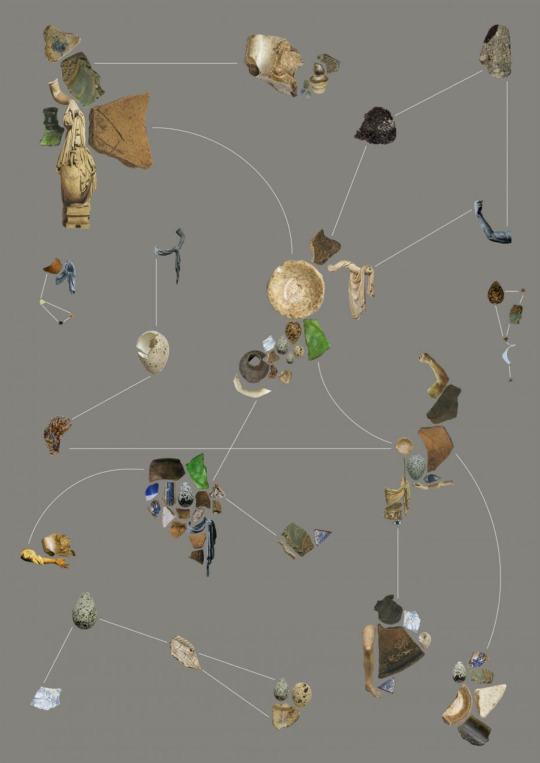
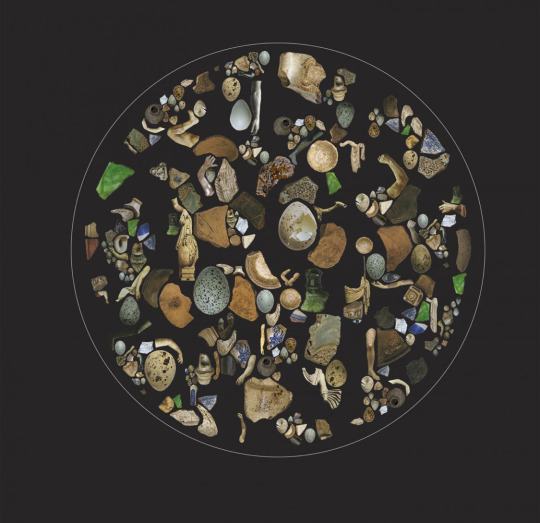
Left and Right: Katherine Scardifield, Ley lines, 2022, photographic image
Ley Lines is a research and exhibition project exploring connections and tracing thread lines between Scotland and Australia. The project seeks to unearth hidden narratives of people and places from within institutional collections, employing a celestial metaphor to reimagine historical objects relating to civic identity, map making and territory charting.
Commissioned by Panel (Glasgow) and created by Kate Scardifield, Ley Lines was developed through a period of collection and archival research during a residency in U.K. supported by Creative Scotland, and through a Research Fellowship with the Museum of Applied Arts & Sciences (MAAS) and Sydney Observatory.
The project uncovered significant artefacts including union banners and maritime signal flags held across six distinct museum collections, and a number of astronomical instruments brought to Australia from Scotland in the 19th Century by the astronomer and former Governor of NSW, Thomas Brisbane (1773-1860). A body of creative work was developed spanning textiles, video and sculpture, including a series of digital prints on velvet and silk produced in collaboration with the School of Textiles and Design, Heriot Watt University.
The outcomes of the project include a touring exhibition presented at four venues in the U.K. The exhibition includes a changing selection of historic material loaned specifically for each venue, allowing new and distinct local narratives to come to light in context with the commissioned work. Soft Chorus, a work developed as part of the commission, comprises of eight unique textiles dyed with native Australian plant material from Parramatta Park, Western Sydney. The work acknowledges the Traditional Custodians of Country, and pays respect to Elders past, present and future.
0 notes
Text
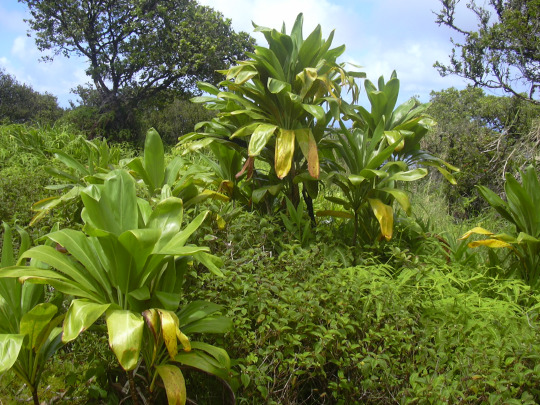





kī / ti: Cordyline fruticosa, a native shrub used for thatching, food wrappers, hula skirts, sandals; alcohol is distilled from the roots
It was planted around one's hale or house to ward off evil spirits. It was plentiful because it would be used in cooking and aesthetically for serving food or beautifying a display of any kind. Soaked in cool water and applied to the forehead would immediately chase away a head ache. If worn around you neck it would immediately cool the entire body. To give a ti leaf lei is a sign of great respect. It is often worn at graduations, weddings and other ceremonial events. It can also be a sign of something lasting.
In ancient Hawaiʻi the plant was thought to have great spiritual power; only kahuna (shamans) and aliʻi (chiefs) were able to wear leaves around their necks during certain ritual activities. Ti was sacred to the god of fertility and agriculture Lono, and the goddess of the forest and the hula dance, Laka. Ti leaves were also used to make lei, and to outline borders between properties it was also planted at the corners of the home to keep evil spirits away. To this day some Hawaiians plant tī near their houses to bring good luck. The leaves are also used for lava sledding. A number of leaves are lashed together and people ride down hills on them. The leaves were also used to make items of clothing including skirts worn in dance performances. The Hawaiian hula skirt is a dense skirt with an opaque layer of at least fifty green leaves and the bottom (top of the leaves) shaved flat.
In Hawaii, the roots mixed with water and fermented are also distilled into an alcoholic beverage known as ʻŌkolehao. It's forerunner was a fermented ti root beverage or beer. When distillation techniques were introduced by English seamen in 1790, it was distilled into a highly alcoholic spirit.
0 notes
Text
Safety Tips for taking kids to Six Flags!!! (English in the top half)
¡¡¡Consejos de seguridad para llevar a los niños a Six Flags!!! (Español cerca de la parte inferior)
(May be applicable to other parties and parks, but this is the one I know)
(I say child singular but groups of lost children will be treated the same)(This information can also sometimes apply to older children or adult dependents)
1. MAKE SURE THEY KNOW AT LEAST ONE PARENT’S PHONE NUMBER!!! Any park worker would be happy to lend your kid a phone instead of escorting a sobbing child to the Lost Parents Area. On the flip side, make sure you have your phone on you. This is the easiest solution.
2. If you can’t find the kid within 5 minutes, IMMEDIATELY TELL A SECURITY GUARD. They will have the whole park searching within minutes. If you are the only adult, do NOT go looking for yourself after that - the security guards need to be able to find you easily to reunite you with the child. They will direct you to Lost Parents, where it is east to reunite you both. If there are 2+ Adults, have at least one wait at Lost Parents and the other can go look*.
3. If a dependent or child notifies a guard that they are lost, the guards will walk the child around the area where they were found once, and if they do not spot you (the adult) the child will be taken to Lost Parents. There they will have to wait until an adult (you) approaches a security guard with the child’s description, and then the guard will take you to Lost Parents. Even if the child knows exactly what you’re wearing and what you look like, the guards will not look for the parent, for resource allocation purposes. It’s not right but it’s the truth!!!
4. If you report first, the security guard will take the dependent or child’s name and description and run it over the radio. All security guards and managers have radios, so as long as the child isn’t actively hiding away from adults, the kid should be found.
5. Children OVER the age of 12 will not be reported, due to resource allocation purposes. But children age 12 and under, as well has dependent Disabled people of any age who may have trouble communicating or realizing they’re lost, will be immediately reported at any time. I don’t make the rules.
6. They will NOT call out your dependent’s or child’s name over the park loudspeakers unless it is past closing.
7. If you are afraid because you do not want attention, because you came to the United States without a green card, the security guards are not police. There are some police officers in the park, but they only wear gray or blue shirts. The security guards don't have much law enforcement and only wear fluorescent yellow-green shirts. The guards only care about the safety of the park and reuniting parents with children.
Español
¡¡¡Consejos de seguridad para llevar a los niños a Six Flags!!!
(Puede ser aplicable a otras fiestas y parques, pero este es el que conozco)
(Digo niño en singular, pero los grupos de niños perdidos serán tratados de la misma manera)(Esta información a veces también puede aplicarse a niños mayores o dependientes adultos)
1. Si tienes miedo porque no quieres atención, por que eres vinó a los estados unidos sin una tarjeta verde, las guardias de seguridad no son policía. Hay algunas agentes de policía en el parque, pero ellos sólo se pongan camisas grises o azules. Las guardias de seguridad no tienen mucha fuerza del ley y sólo se pongan camisas amarillo-verdes fluorescentes. Las guardias sólo se importan sobre la seguridad del parque y reuniendo padres con hijos.
2. ¡ASEGÚRESE LOS NIÑOS DE QUE SEPA AL MENOS EL NÚMERO DE TELÉFONO DE UN PADRE! Cualquier trabajador del parque estaría feliz de prestarle un teléfono a su hijo en lugar de acompañar a un niño sollozante al Área de padres perdidos. Por otro lado, asegúrate de tener tu teléfono contigo. Esta es la solución más fácil.
3. Si no puede encontrar al niño en 5 minutos, DÍGASE INMEDIATAMENTE A UN GUARDIA DE SEGURIDAD. Tendrán todo el parque buscando en minutos. Si eres el único adulto, NO busques por ti mismo después de eso; los guardias de seguridad deben poder encontrarte fácilmente para reunirte con el niño. Ellos lo dirigirán a Lost Parents, donde para reunirlos a ambos. Si hay más de 2 adultos, haga que al menos uno espere en Lost Parents y el otro puede ir a ver por el nino**.
4. Si un dependiente o un niño notifica a un guardia que se ha perdido, los guardias caminarán con el niño por el área donde se encontraron una vez, y si no lo ven a usted (el adulto), el niño será llevado a Lost Parents. Allí tendrán que esperar hasta que un adulto (tú) se acerque a un guardia de seguridad con la descripción del niño, y luego el guardia te llevará a Lost Parents. Incluso si el niño sabe exactamente lo que llevas puesto y cómo te ves, los guardias no buscarán al padre, con fines de asignación de recursos. No esta bien pero es la verdad!!!
5. Si informa primero, el guardia de seguridad tomará el nombre y la descripción del dependiente o del niño y lo transmitirá por radio. Todos los guardias de seguridad y los gerentes tienen radios, por lo que siempre que el niño no se esté escondiendo activamente de los adultos, se debe encontrar al niño.
6. No se reportarán niños MAYORES de 12 años, por motivos de asignación de recursos. Pero los niños menores de 12 años, así como las personas discapacitadas dependientes de cualquier edad que puedan tener problemas para comunicarse o darse cuenta de que están perdidos, serán informados de inmediato en cualquier momento. Yo no hago las reglas.
7. NO gritarán el nombre de su dependiente o de su hijo por los altavoces del parque a menos que haya pasado el cierre.
*If you are the adult staying at Lost Parents, suck it up and stay. The only reason you should get up is if you have to go to the bathroom (and there’s always one nearby for the kids) or if you are in danger of passing out from hunger. And even then, ask a friend to get you food! The lines are very long, and you could miss valuable time reuniting with the child if you are out waiting for food.
** Si eres el adulto que se hospeda en Lost Parents, aguanta y quédate. La única razón por la que debes levantarte es si tienes que ir al baño (y siempre hay uno cerca para los niños) o si corres el riesgo de desmayarte de hambre. E incluso entonces, ¡pídele a un amigo que te traiga comida! Las filas son muy largas y podría perder un tiempo valioso para reunirse con el niño si está esperando comida.
#Six Flags#theme parks#traveling with kids#American theme parks#Canadian theme parks#Mexican theme parks#sorry I don’t know what else to tag this#my friend lost her kid at the park today and freaked the Fuck out and#the kid was basically already found but she acted like a fool#so the kid had to wait half an hour instead of 5 minutes of being lost#anyway I looked up the policies and thought I’d share#sorry for the shitty Spanish but someone else on the internet mentioned#how they were lost for a while because their parents were afraid to go to the guards
0 notes
Text
After officially hiking tariffs on Chinese electric vehicle imports earlier this month, the US government is getting even more serious about keeping China-made autos out of the country. On Monday, the US Commerce Department proposed a new rule that would ban some Chinese- and Russian-made automotive hardware and software from the US, with software restrictions starting as early as 2026.
The Biden administration says the move is needed for national security reasons, given how central technology is to today’s increasingly sophisticated cars. In announcing the proposed ban, Commerce Secretary Gina Raimondo cited vehicles’ internet-connected cameras, microphones, and GPS equipment. “It doesn't take much imagination to understand how a foreign adversary with access to this information could pose a serious risk to both our national security and the privacy of US citizens,” she said.
The US government’s move comes as China has dramatically increased the number of affordable vehicles, and especially electric ones, it makes and sells overseas. Chinese auto exports grew by more than 30 percent in just the first half of this year, setting off alarm bells in Europe and the US, where officials worry inexpensively made Chinese vehicles could overwhelm domestic industry. The US and Europe had moved to make it harder and more expensive for China to sell its autos in those regions, but the Chinese automakers have responded by setting up manufacturing bases in Eastern Europe, Africa, and Mexico—all of which might one day provide a loophole to allow more Chinese-designed and engineered vehicles into new Western markets.
Still, the proposed rule focuses on security rather than competition. Raimondo had previously raised the specter of foreign actors using hijacked connected car technology to cause mayhem on the US public roads. “Imagine if there were thousands or hundreds of thousands of Chinese connected vehicles on American roads that could be immediately and simultaneously disabled by somebody in Beijing,” she said in February.
That situation isn’t quite realistic, given how few Chinese and Russian firms supply automotive software or hardware in the US right now. A proposed software and hardware ban is more preemptive than a response to any immediate security risk, says Steve Man, the global head of auto research at Bloomberg Intelligence, a research and advisory firm. “PRC and Russian automakers do not currently play a significant role in the US auto market, and US drivers right now are safe,” a senior Biden administration official told WIRED.
Because the rule would apply to any connected vehicle, not just electric ones, it would create even stronger prohibitions against Chinese-made auto tech. "If the 100 percent tariffs on made-in-China EVs were a wall, the proposed ban on connected vehicles would be a death sentence for China EV Inc. aiming to enter the US,” says Lei Xing, the former chief editor at China Auto Review and an independent analyst. Under such a rule, he says, the prospects of seeing Chinese EVs on sale in the US in the coming decade is “nearly zero.”
If finalized, the new rule would only apply to automotive hardware and software able to receive or process radio frequency communications, and software integrated into vehicles’ automated driving systems, the Commerce Department says. It would not apply to autos’ “passive” parts, including fasteners and plastic covers. The rules would begin to take effect in model year 2027 vehicles and be fully implemented by 2030.
The rule will now move to a public comment period, and the Commerce Department would likely finalize it before President Joe Biden leaves office in early 2025.
The US auto industry seems to believe the rules are a step in the right direction. In a statement, John Bozzella, the president and CEO of the Alliance for Automotive Innovation trade group, called the government's process of developing the proposed rules “thoughtful.” While their lead time would allow some auto manufacturers to find new software and hardware suppliers, he said, “the required transition but may be too short for others.”
Chinese tech and auto companies—including Huawei, Tencent, Baidu, BYD, and Geely—have invested heavily in developing their own software and hardware for self-driving cars. But so far these products are almost all used on cars sold in the Chinese markets.
The US government has used similar logic to push back against the incursion of other Chinese technology in the US. In 2022, it banned the approval of some equipment from the Chinese telecommunications firms Huawei and ZTE, also citing national security concerns. This spring, President Joe Biden signed a law that would force TikTok’s parent company, the Chinese firm ByteDance, to divest from the social media app or face a ban. TikTok has challenged the law in court.
The US government’s proposed ban on Chinese connected vehicle software is similar, says Man, the auto analyst. “This is a TikTok move,” he says.
4 notes
·
View notes
Text
N.S. receives thousands of applications from internationally-trained nurses since fast-tracking process
Nova Scotia’s College of Nursing has received a thousands of applications from internationally-trained nurses hoping to practice in the province.
Sue Smith, the CEO and registrar of the Nova Scotia College of Nursing (NSCN), said the college has received 9110 applications since it expedited the licensing and registration process for the top seven countries where nurses apply to come to Canada.
“We’re in day eight and we’ve had well-over 9000 applicants,” Smith said. “It’s all hands-on deck.”
The Nova Scotia College of Nursing was the first provincial regulator to announce plans to fast-track applications for international nurses who are trained in the seven countries where the scope practise matches Nova Scotia’s. This means nurses would be eligible for licenses in a matter of weeks, rather than years.
Nurses registered in the Philippines, India, Nigeria, the U.S., the United Kingdom, Australia and New Zealand are now eligible to apply for a license in Nova Scotia and have no other requirement except pass a national entrance exam.
The stream-lined process has cut out paperwork and time.
Smith noted while the college was anticipating there would be a lot of interest, more than 9000 applications within eight days exceeds expectations.
“This does not automatically translate into 9000 nurses however based upon even the high high number of people who are filling out an account we are very optimistic that we will certainly have significant positive number of nurses available to work in Nova Scotia,” Smith said.
CTV news spoke with Janet Hazelton, president of the nurses union, earlier on Wednesday at which point in which the Nova Scotia College of Nursing had received more than 1400 applications within the first two days of the process. Even having heard the much smaller number, she was pleased.
“I’m shocked and I’m pleased but I’m cautiously optimistic,” Hazelton said. “Because they still have to be obviously vetted to make sure they meet the standard we hold in our province. There’s still some work to be done but it’s certainly promising.”
Hazelton estimates there are somewhere between 1200-1500 vacancies within the Nova Scotia Health Authority, which does not count the IWK or long-term care nurses.
While Nova Scotia was the first province to introduce the licensing changes, Alberta and British Columbia have followed suit.
“That’s always the issue when you have a good idea. It germinates and others latch onto it,” said Hazelton.
Nova Scotia’s health minister Michelle Thompson believes the initial interest shows that people have been waiting for changes for a long time.
“We’re really proud of the college and the work that they’ve done and you see that we’re reaping the benefits of that change,” Thompson said.
On Tuesday, the college convened a meeting with healthcare and immigration stakeholders, including the Office of Healthcare Professionals Recruitment.
“It certainly mobilized a whole crew of people quite quickly to say ok this is a real opportunity,” said Suzanne Ley, senior executive director of the Office of Healthcare Professionals Recruitment.
“It’s one thing for us to be doing recruitment around the world, which we’ve been doing but this is recruitment coming to us,” she said.
While licensing is key, so is finding a place for new nurses to work and live.
“As we get these folks we want them to stay in Nova Scotia,” said Smith. “Other partners also have to step up and we wanted to give them a heads up.”
Ley also noted there are lots of internationally-educated nurses in Nova Scotia already.
“And so there’s some work happening to make sure we’re taking care of some of the folks that are here,” Ley said.
As for the applicants who are still abroad, Ley expects it could take anywhere from months to a year to get them to Nova Scotia, depending on their individual circumstances.
For the latest Nova Scotia news, visit our dedicated provincial page.
from CTV News - Atlantic https://ift.tt/Bjy6x5P
0 notes